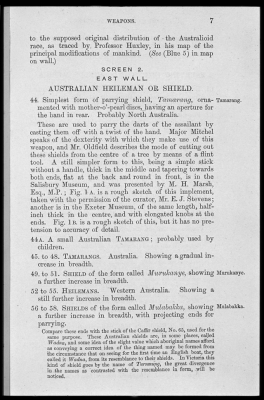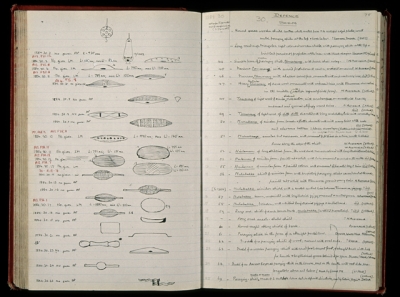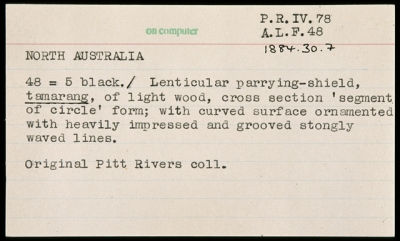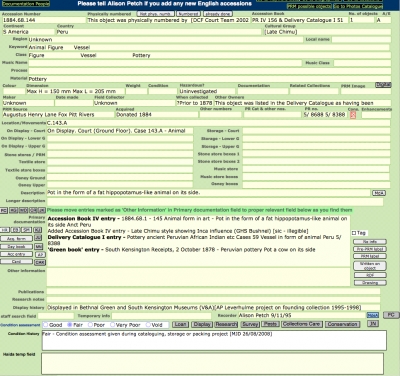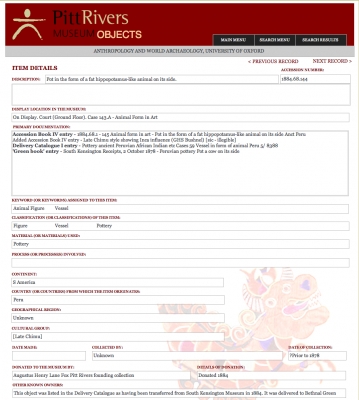To search the RPR site click here
Number of objects in the founding collection
On 24 May 2010 19,606 objects had been accessioned by the Pitt Rivers Museum, University of Oxford from the founding collection of Pitt-Rivers. It may seem surprising, but this figure continues to increase. The following text tries to explain why the founding collection is less well accessioned than might be expected, some 126 years after it was first agreed that the collection would be donated to the University of Oxford.
In 1981 Chapman in his masterly overview of the Pitt Rivers' founding collection estimated that there were around 14,000 objects in the collection. In 1998 the first systematic listing of all the founding artefacts then known resulted in a count of 16,936 objects, with an estimate of 6,700 more objects for which there appeared to be documentation. [Petch, 1998: 73] Only a year later this figure had increased: in 1999 it was estimated that there were 17,300 objects in the founding collection, and we knew there were probably many more. [Petch, 1999: 98] Each year several hundred more objects have been found unentered in the Museum's accession registers and have been formally accessioned. In 2004-5 it was estimated that the collection totalled 18,107 objects. [http://history.prm.ox.ac.uk/page_48.html] By 2006, the figure had risen to 18,752. [Petch, 2006: 257] In only a further four years to 2010 a further 1,000 objects have been retrieved and added to the Museum's registers. This process will continue into the future as museum staff find more objects in the course of their researches into the collections. Today the founding collection probably represents around one-fifth of the overall object collection, but less than 5 per cent of the total Pitt Rivers Museum's collections.
Until 1874 Pitt-Rivers kept the contents of the founding collection in his home in London; Tylor in his Dictionary of National Biography entry for Pitt-Rivers describes the collection lining the walls of the house from the attic to the cellar. No documentation for the collection survives from this time: indeed, it is not even known whether Pitt-Rivers kept any. From 1874 at least part of the collection was lent to the Victoria and Albert Museum authorities in London (then known as the South Kensington Museum). At first the collection was displayed at Bethnal Green Museum (a branch of the main museum) until 1878 when the collection was redisplayed in the main museum. The only documentation directly written by Pitt-Rivers about some of the artefacts in the founding collection is his published catalogue of the weapons displayed at Bethnal Green Museum. He had supposed, when he first lent the collection, that he would produce a published catalogue for other sections of the display as well, but these were never written. An example of a page of this catalogue is shown.
Obviously the museum authorities kept their own records for their collections and from their time date two principal sources of information now held by the Pitt Rivers Museum at Oxford. The first is a so-called day book (sometimes called by the Pitt Rivers Museum staff the 'green book') which lists the deliveries of new objects to the South Kensington Museum from Pitt-Rivers between 1874 and 1884. Each time Pitt-Rivers sent a new batch of objects these were listed in the day book for the specific day; usually each object (or batch of similar objects) was given a one-line description, sometimes including data about the source. Typical examples might read:
'Green book' entry - South Kensington Receipts, 1 January 1874 - 1 Japanese painting on tissue (life size) (this describes 1884.117.41)
or
'Green book' entry - South Kensington Receipts, 16 and 17 January 1878 - Objects chiefly from Mr J.G. Wood's collection 94 1 N American ornament paddle (this describes 1945.10.128 [1])
The copy held by the Pitt Rivers Museum appears to be a reasonable photocopy which suggests it was received late in the twentieth century, though when or why is not known. It may have come to the Pitt Rivers Museum as a result of the research carried out by Bill Chapman for his D.Phil thesis completed in 1981. After research carried out by Petch in the 1990s, it became clear that the complicated numbers associated with some objects in the founding collection (for example 651/ 12394) corrolated with the list position in the green book. That is, all objects associated with a 12394 number were listed together and the number 651 meant it was the 651st object given on that day.
The second form of documentation surviving from South Kensington Museum days appears to be some notebooks listing parts of the founding collection, the so called 'Blue', 'Red' and 'Black' books (though now they are bound into two volumes and do not have covers of this colour). It is not clear what these represent or why they only cover part of the collections. The copies held by the Pitt Rivers Museum appear to be the handwritten originals. A typical entry (actually rather longer than some) might be:
Blue book entry - Representative Art Case 66 608 Deer and sledge Carved in ivory by Laplanders (2800)
Added Blue book entry - Ostiak (this entry describes 1884.1.6)
A final form of documentation, which might date from the South Kensington days, or from the early days when the founding collection was at the Oxford University Museum, are three catalogue volumes of the items donated by E.H. Man from the Andaman and Nicobar Islands. These are numbered PR III and PR VII and PR VIII. They appear to be lists made by Man of each of his items, but they are not matched against specific objects except by name of type of object. Several of the items listed in these volumes did not come to the Museum via the founding collection but via other sources which suggest that the books are not directly connected to the founding collection. A typical example might read
Accession Book III entry - 113. Toddy strainer [vide vol XI pl XXV] and drinking vessel [vide vol XI pl XXV]. The former is placed over the latter which thus receives the strained liquid. The contents are then sucked through the tube provided for the purpose [EH Man 1881]
Accession Book VII [Nicobar objects] entry - 67 tanòp toak Bamboo drinking vessel provided with a tube for sucking toddy. Is in constant use among the middle aged and old men of Chowra, Teressa and Car Nicobar especially the former. Is not used in the Central and Southern groups where toddy is drunk either from an enfâ (item no 36) or a glass or by pouring direct from the shanònha-toak into the mouth [EH Man 1886](Note that these entries describe 1884.7.68)
A similarly undated source is a book called 'Collectors Miscellaneous' which gives short descriptions of some items from some collectors (not all represented in the founding collection). It seems possible that this dates from the early days of the Pitt Rivers Museum, but it could be earlier. Again it is a handwritten document, which was obviously bound from a series of existing notebooks. Much of it is very difficult to read. A typical entry would read:
Collectors Miscellaneous XI accession book entry - J. Miln? 278 Brittany Carnac. Halter blessed by St. Cornély to keep disease from cattle (this describes 1884.56.25)
This catalogue does not contain entries for every founding collection item.
The founding collection was transferred to Oxford in 1884-5 from the South Kensington Museum. Walter Baldwin Spencer worked with Edward Burnett Tylor and Henry Nottidge Moseley to transfer the collections, producing two volumes of catalogues as items were boxed ready for transport (these catalogues are now known as the 'Delivery Catalogues' and duplicate copies held by the Pitt Rivers Museum). However, these volumes are handwritten, apparently in some haste, and are difficult to read, and even more difficult to match against the actual objects in the founding collection because relatively little information was noted and not all the numbers written on the objects were recorded. Spencer and Henry Balfour then worked together on the collections when they first arrived at the Oxford University Museum until Spencer left for Australia and his new post as Professor of Biology at the University of Melbourne. Henry Balfour, of course, remained working on the collection and eventually became the Curator (Director of the Museum). To find out more about him please see here. To find out more about the transfer, see here.
Henry Balfour is responsible for another incomplete listing of the founding collection. He was particularly interested in some forms of artefacts, for example musical instruments and fire-making equipment. Presumably for his own research he created several notebooks about particular forms of object which include some objects from the founding collection. These contain more detailed descriptions of the objects, and sometimes drawings. Here is a typical example:
Balfour Catalogue Red numbers: Containers other than Pottery - C Bamboo PR Coll Vessel used in drinking toddy (tari) called 'tanòp-toak', made of a single joint of bamboo closed by a node below, open above, through a hole close to the rim is passed a flexible tube for sucking up the liquid as through a straw. Used by middle aged and old men. Northern Ids of Nicobar group Obtd by EH Man esq Presd ..... [information not given] The enfâ or cocao nut cup is used in the Central and Southern groups v Man's ms Cat no 67 (Note that this again describes 1884.7.68)
For some reason no formal detailed catalogue of the founding collection was created until some thirty years after it was received. So far as can be worked out, some time during the 1920s several volumes of handwritten catalogues (known as accession books, PR IV, V and VI) were produced listing the founding collection items. Most of these appear to be based upon the displays in the Museum (the theory that items are listed in the order that they are shown in the display is confirmed where the catalogues and surviving photographs of displays can be checked against each other). It is believed that Ernest Seymour Thomas, an assistant to Henry Balfour, produced the catalogue. A typical entry from one of these volumes might read:
Accession Book IV entry - 1884.58.1 - 122 Religious emblems: Images and Accessories - Bronze figure of a boar, with punched 'dot' pattern (form of Rudra and Indra) Hindu (54 in ink)(this describes 1884.58.16)
or
Accession Book V entry - 1884.118.1 - 273 Implements Bone Ivory Horn - Barbed ivory harpoon head with long barbed head, narrow with axe-shaped projection behind near top W Eskimo (20R) [Drawing](this describes 1884.118.28)
No systematic effort was made to collate these volumes with the delivery catalogues or with the day book volume from South Kensington Museum. However, in many cases the numbers written on the objects were noted, and some attempts were made to collate entries with the entries in the 'blue', 'red' and 'black' books. They were not collated with Balfour's own notebooks, suggesting that these were for his own personal research rather than museum holdings at this date.
Sometime during the 1930s, Balfour seems to have decided to ask volunteer workers to prepare catalogue cards for specific types of objects like smoking-related objects, or amulets. Many of the descriptions included on these cards are quite detailed and show that the artefacts were researched in some detail. Some of the founding collection items were included in these card catalogue series. An example of this type of entry, prepared by Francis Knowles, is given below:
Detailed Pipes [Unsorted] Card Catalogue entry - Description: Cast of ancient tobacco pipe made from a fossil shell. The shell was a large cockle shaped bivalve, the bowl was hollowed out in the flattened side and the hole for the pipe stem bored in the deep groove between the two curved and blunt pointed ends. The original seems to have been a fossil 'cast' of the inside of the shell. Length 6.8 cm width 5.4 cm measured across and down the heart shaped flattened side of the shell cast Locality: Mississippi USA How Acquired: PR coll [Drawing](the entry describes 1884.101.1)
After the late 1930s Pitt Rivers Museum accession books (including those for the founding collection) were used to prepare two card catalogue systems; one sorted into geographical provenance, the other into type of artefact. These contained the information given previously in the accession books but made finding specific information for specific objects much easier. Some of the cards (though not many for the founding collection) are illustrated. Here is a typical entry:
Card Catalogue Entry - AFRICA. NILOTIC REGION. 788 ./. ?488 Black ./. Spear w. 2 blades [sketch] set at right [=angles] to shank & spirally twisted. "Nilotic medicine spears put in the house of divination" J.H. Driberg, 10.1.21. Similar spear w. no shank above socket. ?copper blade (this describes 1884.19.194)
Finally, a systematic attempt was made to work out exactly how many objects there were in the founding collection in the mid 1990s when the Leverhulme Trust funded a research project to produce a full, computerised, catalogue. The author was also the researcher who worked on that project. Computer entries were made for each of the objects listed in the accession book and then all the other sources (with the exception of the catalogue cards) were mapped against these entries. This process proved that there were many more founding collection artefacts which had not been accessioned but which the Museum had information about; these were placed in a separate database and this resource has been used ever since to identify and finally accession previously unaccessioned founding collection items.
After this first Leverhulme Trust project the primary documentation about the artefacts in the founding collection was for the first time collated in one place and easily available. A typical catalogue entry might now read:
Accession Book IV entry - 1884.29.1 - 30 Weapons Slings Lassos and bolas Lasso (44ft) of plaited hide, 4-strand, with noose ring of iron at one end and a knot at the other, with a flat strap plaited into the end and button-hole fitting over the knot to fasten it to the saddle Araucanian S America JG Wood coll [106] 21.1.78>
Additional Accession Book IV entry - v Muster's Patagonia
Collectors Miscellaneous XI Accession Book entry - as IV
Delivery Catalogue I entry - Whips etc Araucanian lasso 106 3546 Screen 204
'Green book' entry - South Kensington Receipts, 16 and 17 January 1878 - Objects chiefly from Mr J.G. Wood's collection 106 1 Araucanian lasso(these all describe 1884.29.24)
Since then a succession of MLA funded DCF (and successor) projects have been systematically examining objects on display. As a result of this examination many of the original labels attached the objects have been transcribed. There are two types, labels predating the Pitt Rivers Museum for example
Pre-PRM label [stuck to .2]- [printed:] FROM BRYCE WRIGHT, 90 GT. RUSSELL ST., LONDON. [handwritten:] 8.X.75 New Guinea.
And ones attached during the early years of the Pitt Rivers Museum:
Pitt Rivers Museum label - Pair of wide armlets of finely plaited thin straw. NEW GUINEA Purch...Bryce Wright P.R. Coll..8.X.75 [rev:] 1884.82.331.1-2 (both of these describe 1884.82.331 .1-2)
or
Pitt Rivers Museum label - Lasso of plaited raw-hide with iron ring for the noose, & strap & button for attachment to saddle. ARAUCANIAN, S. AMERICA. From the Rev. J. G. Wood's colln., 21. Jan. 1878. P.R. coll. (3546)(for 1884.29.24)
It is not known how big the founding collection really was but it could be as many as 25,000 separate artefacts. It certainly numbers more than the 20,000 which the Museum currently estimates it at.[2]
AP, 24 May 2010
Notes
[1] Note that this item has a strange accession number rather than the more usual 1884.X.X because when it was first re-found in 1945 it was not known that it had been donated by Pitt-Rivers and was thought to have been given by Henry Balfour.
[2] A further uncertainty derives from the fact that some sorts of objects have only ever been 'batch-catalogued', for example stone tools and pottery sherds. It is likely that the guesstimates included in the founding collection catalogue as of now are underestimates. The total for the founding collection as at February 2013 was 22830, this number is likely to increase over 2013 as the Excavating Pitt-Rivers project continues to find unentered items.
Bibliography for this article
Bowden, Mark 1991. Pitt Rivers: The Life and Archaeological Work of Lieutenant-General Augustus Henry Lane Fox Pitt Rivers, Cambridge: Cambridge University Press.
Chapman, William Ryan 1981. ‘Ethnology in the Museum: A.H.L.F. Pitt-Rivers (1827–1900) and the Institutional Foundations of British Anthropology’, University of Oxford: D.Phil. thesis.
Fox, A.H. Lane 1874. Catalogue of the Anthropological Collection lent by Colonel Lane Fox for exhibition in the Bethnal Green branch of the South Kensington Museum June 1874 Parts I and II. London, Science and Art Department of the Committee of Council on Education HMSO [Re-issued 1879]
Petch, Alison 1998. ‘“Man as he was and Man as he is”: General Pitt Rivers’s Collections’, Journal of the History of Collections, Vol. 10 no. 1, pp. 75–85.
Petch, Alison. 1999. Cataloguing the Pitt Rivers Museum founding collection. Journal of Museum Ethnography 11 1999 pp. 95-104
Petch, Alison. 2003. 'Documentation in the Pitt Rivers Museum’ Journal of Museum Ethnography, No. 15 pp. 109-114
Petch, Alison. 2006 [a]. 'Chance and Certitude: Pitt Rivers and his first collection' Journal of the History of Collecting 18 pp. 249-256
Petch, Alison. 2006 [b]. ‘Counting and Calculating: Some reflections on using statistics to examine the history and shape of the collections at the Pitt Rivers Museum’ Journal of Museum Ethnography, 18 pp. 149-156
Petch, Alison. 2007. 'Opening the Pitt Rivers Museum' Journal of Museum Ethnography 19 pp. 101-112
Thompson, M.W. 1977. General Pitt Rivers: Evolution and Archaeology in the Nineteenth Century Bradford-on-Avon: Moonraker Press.
Please note that all founding collection information on the museum's database can be found by members of the public here.
Alison Petch, 2010.

